Ms Zhang is the 49-year-old founder of Nine Dragons Paper, which buys scrap paper from the US for use in China.
Her wealth rose from $375m last year, when she was 36th in the annual China Rich List, compiled by Hurun Report.
Nine Dragons' shares have almost tripled in value since they were listed on the Hong Kong stock exchange.
Ms Zhang is now the richest self-made woman in the world, ahead of US TV celebrity Oprah Winfrey and Harry Potter author J.K. Rowling.
She takes over the top position from retail magnate Huang Guangyu of Gome Electrical Appliances.
There are 35 women on the 500-strong Hurun list, which contains 15 billionaires, double the number from 2005.
In July, Chinese president Hu Jintao called for greater measures to tackle the wealth gap.
The divide has accelerated as market forces exert a greater control over the economy, which grew at 11.3% in the second quarter of 2006.
http://news.bbc.co.uk/1/hi/business/6039296.stm
 | | By Alam Srinivas Business editor, Outlook magazine |
 Ratan Tata has now emerged as a global player |
India's Tata Steel has won the battle to take over the Anglo-Dutch steelmaker Corus by making a £5.75bn ($11.3bn) bid.
Tata chairman Ratan Tata is not among the Forbes' list of 40 richest Indians around the world.
His sprawling business empire is no longer the largest among privately-owned Indian groups.
He's not even considered the most powerful businessman in India.
More importantly, there's still a lack of clarity about who'll be his successor after his planned retirement in 2012.
But he's one of the most respected corporate chieftains in India.
And when London-based steelmaker Corus agreed to his takeover bid in October, he had arrived on the global arena.
Aggressive and ambitious
That's a short snapshot of Ratan Tata, 69, who controls the $22bn Tata group, which includes 96 companies manufacturing a range of products from automobiles to watches, steel to fertilisers.
The takeover - the largest by any Indian company - marks yet another transformation in the corporate image of Ratan Tata during his 15 years' stint as the group chairman.
Today, the smooth, suave, and introvert Ratan is being seen as an aggressive and ambitious businessman, whose strategic vision has shifted from local to global.

This change started in February 2000, when Tata Tea purchased the UK-based Tetley for over $400m. In the financial year 2005-06, the group made 14 acquisitions (worth nearly $1.5bn).
In a recent interview to an Indian magazine, Ratan Tata said: "We were very obsessed with ourselves in India. So, I have felt for some time that we didn't need to be that."
Today, nearly a third of group revenues, some $6.7bn, comes from overseas markets.
"I think we've only just begun. If we stay in India, we'll be at a competitive disadvantage," Alan Rosling, director, Tata Sons, which is the group's holding company, told Reuters recently.
This realisation has struck many Indian promoters and, after the Tata-Corus deal, India's Foreign Direct Investment (FDI) outflows will exceed FDI inflows in the first seven months of this financial year.
But it hasn't been a smooth ride for Ratan Tata. When he became the chairman in 1991, he was seen as a pushover by the group companies' CEOs, who lorded over their entities.
He had to battle it out with these satraps, who treated their companies as their fiefdoms. So, the new chairman eased out CEOs like Rusi Mody (of Tata Steel) and Ajit Kerkar (Indian Hotels).
Revamps
In the late 1990s, two of the top firms, Tata Steel and Tata Motors went through tumultuous crises and were saddled with huge losses.

Ratan revamped the operations of Tata Steel and made it one of the lowest-cost producers in the world.
He made the critics eat their own words, when he launched India's first indigenous car, Indica, which turned around Tata Motors' fortunes.
As the group entered the 21st Century, Ratan Tata was obsessed with four critical issues.
The first was to globalise his group's operations, where he has succeeded to a certain extent.
The second was to safeguard his companies against possible hostile takeovers after the London-based Indian, Lakshmi Mittal, purchased the Luxembourg-based Arcelor early in 2006 to become the world's largest steelmaker, and announced his ambitious plans in India.
So, to thwart any threats, Tata decided to up his stakes in most of the group companies.
Ratan Tata's most important concern, however, was to protect his top lines and bottom lines in the face of ever-increasing competition from domestic and global players.
To achieve this objective, he had no option but to become aggressive, a quality that helped him in other areas.
Today, the group, which was seen as risk-averse and cautious, has no qualms about taking on competitors publicly - be it in areas of policy-making, products launched or marketing tactics.
Staying on
Finally, the unmarried Ratan Tata had to look for a successor.
There were several candidates - including his step-brother, Noel - but none of them had an established track record. Some of them didn't have the character to carry on the legacy of a group that's synonymous with reliability of products, honesty, integrity and public service.

When he couldn't find a credible contender, Tata decided to take the bull by the horns and postponed his retirement.
Last year, the retirement age for non-executive directors of Tata Sons, the holding company, was raised from 70 to 75 years.
Thanks to that, Tata, a non-executive director, who was to retire in 2007, got a five-year extension.
Now it appears it is time for Ratan Tata to establish himself on the global map. The Corus buyout makes Tata Steel the world's fifth largest steelmaker.
But it needs to play the catch-up game with Mittal. Tata has to do the same with Mukesh Ambani, the promoter of India's largest private sector firm, Reliance Industries, which aims to be among the top 100 in the Fortune 500 list.
Ratan Tata has a long way to go before he can bid farewell (or "tata" to use the Hindi word) to the world of work.
http://news.bbc.co.uk/2/hi/south_asia/6071090.stm
3rd Client: Carlos Slim
Carlos Slim, the richest man in the world
The son of a Mexico City shopkeeper has built a staggering $59 billion fortune. Fortune's Stephanie Mehta tells the inside story of how he made it to the top.
(Fortune Magazine) -- I remember there was a time when the value of his enterprises was very low," recalls Patrick, the youngest son of Carlos Slim Hel�. It was the early 1980s, and Mexico was in the depths of a massive financial crisis. Periodically the elder Slim would round up his three teenage sons for an economics lesson. Sitting them down in the living room of the family home, Slim would produce a single handwritten list. One line would show, for instance, how a Mexican insurance company was selling for far less than a similar American insurer. Another would show that compared with European candy or cigarette makers, Mexican manufacturers were drastically undervalued. "It was a very, very long time ago," says Patrick, "but I absolutely remember him teaching us at an early age."
For Slim, a onetime math instructor, this was no mere academic exercise. Yes, he wanted to instill in his sons the same lesson his father - a Lebanese immigrant who started acquiring real estate in Mexico City during the Revolution of 1910 - taught him: Though Mexico will have its ups and downs, don't ever count the country out. But Slim wasn't just teaching, he was buying. He spent $55 million on an insurance company. He took a stake in retailer Sanborns. He invested in a hotel chain.
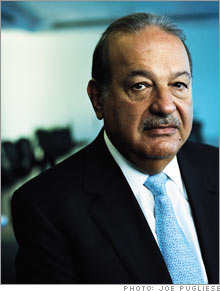 |
| Wireless wealth pushed Carlos Slim Helu to the top of the rich list. |
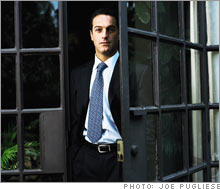 |
| Firstborn Carlos Jr. - the only bachelor among the brothers - cut his teeth on the family's retail chain, Sanborns. |
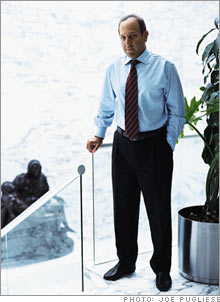 |
| Marco Antonio is known as the moneyman. |
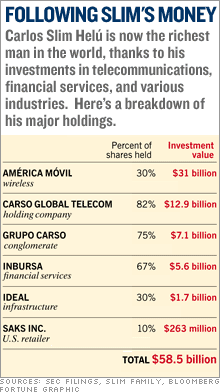
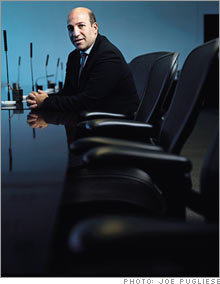 |
| Patrick helps run America Movil, the Slim's most valuable division. |
| ||||||||||||||
| • Top 25 |
Now those early investments are paying off big time. His three heirs - Carlos Jr., 40; Marco Antonio, 39; and Patrick, 38, run day-to-day operations at various Slim businesses and are increasingly making strategic decisions, while their father, who had heart surgery in 1997, pulls back. And Slim's investments in downtrodden Mexico? They laid the foundations of a sprawling, $150 billion business empire whose growth in recent months has turned Carlos Slim Hel� into the world's richest man.
By our calculations, the 67-year-old Slim has amassed a $59 billion fortune, based on the value of his public holdings at the end of July. This number puts him just ahead of perennial No. 1, Microsoft founder Bill Gates, whose net worth is estimated to be at least $58 billion. But Gates is selling off his single greatest source of wealth, Microsoft stock, to fund his foundation, while Slim's fortune is growing at a stunning clip. His net worth jumped $12 billion this year alone. His family's holdings represent more than 5% of Mexico's 2006 gross domestic product, and Slim-controlled companies make up one-third of the $422 billion Mexican Bolsa, or stock exchange.
Portly and often puffing a cigar, Slim could pass for a latter-day Latin American J.P. Morgan. But with his dominant stakes in everything from phones to finance, his business profile more closely resembles that of John D. Rockefeller, who likewise thrived in a loosely regulated environment. (For the record, though, even in current dollars Rockefeller's wealth pales in comparison to Slim's: At his death in 1937, Rockefeller was worth $20.3 billion, representing one fifty-second of 1937 U.S. GDP.) The average Mexican encounters a Slim-owned business when she visits an ATM, drives a car, stops for coffee, and especially when she picks up the phone - Slim's Tel�fonos de M�xico controls 92% of the country's phone lines, and his Am�rica M�vil wireless service has a 70% market share. George W. Grayson, a professor of government at the College of William & Mary, coined the term "Slimlandia" to describe how entrenched the Slim family's companies are in the daily life of Mexicans.
It's not a reverential term. Many Mexicans hoped privatization, which began in the early 1990s, would create competition and drive prices down drastically. That hasn't happened. "Slim is one of a dozen fat cats in Mexico who impede that country's growth because they run monopolies or oligopolies," says Grayson. "The Mexican economy is highly inefficient, and it is losing its competitive standing vis-�-vis other countries because of people like Slim."
"The accusations are not well-founded," Carlos Jr. fires back during an interview. He then pulls out an analyst's report showing how the average price of long-distance phone service in Mexico compares with that in other countries. Mexico is third cheapest, according to the report, behind the U.S. and Finland. (A recent study by the World Bank paints a different picture, showing that Mexico's rates for monthly service and residential phone hookups are among the highest in the developing world.)
Wooing the public isn't exactly a favorite activity for the Slims. "I think sometimes when you are successful in business," says Slim in heavily accented English, "you have others trying to turn public opinion against you because they are trying to compete with you." Slim, however, is beginning to court public opinion, pledging earlier this year to increase the size of his charitable foundations. Meanwhile, his sons are doing what the Slims do best: making more money.
***
Anyone expecting to find monuments to the Slim financial empire in Mexico City - a gleaming TelMex tower jutting out of the skyline or an Am�rica M�vil stadium - would leave disappointed. In fact, Am�rica M�vil, Latin America's largest provider of wireless services, is housed in a converted tire factory. The juxtaposition of austerity and wealth can be quite odd, as evidenced by a recent visit to the headquarters of Inbursa, Slim's financial business. Just beyond the lobby is a makeshift art gallery that features a rotating selection of paintings on loan from the Museo Soumaya, a Slim-financed fine-arts museum named after his wife, who died in 1999. The room is a bit shabby. It is poorly lit and smells faintly of cigarettes; several large crates are propped against one of the walls. "We had several El Grecos here," Arturo Elias Ayub, Slim's son-in-law and spokesman, says matter-of-factly. There's also a folding table in the center of the room. "Mr. Slim sometimes likes to eat his lunch here," Elias adds.
The famous Slim thrift - he used to show up for business meetings wearing a cheap calculator watch - extends across the entire company. Years ago he wrote "official principles" for Grupo Carso, his industrial conglomerate, which are distributed annually to all employees. One tenet translates into English as follows: "Maintain austerity in prosperous times (in times when the cow is fat with milk); it accelerates corporate development and avoids the need for drastic change in times of crisis." So, for example, TelMex's net debt equals Ebitda, or earnings before interest, taxes, depreciation, and amortization, a statistic that's unheard-of in its industry, where debt is typically three times cash flow. Am�rica M�vil actually has less debt than Ebitda. "They're rabid about costs," says New York-based Citi investment research analyst Patrick Grenham. "They borrow as little as possible and very carefully."
Slim inherited his head for numbers - and his knack for bottom-fishing - from his father, Julian, who fled to Mexico in 1902 to avoid the Ottoman Empire's military draft. Julian Slim started a general store and bought commercial real estate in downtown Mexico City during the 1910 Revolution. He required his young son to record his childhood purchases in notebooks; Slim, a bit of a pack rat, keeps some of the ledgers on a shelf in his office.
Though he taught math to make money in college, Slim graduated with a degree in engineering from the National Autonomous University of Mexico in the early 1960s. He then started a stock brokerage in Mexico City and began to acquire industrial companies he deemed bargains. He would reinvest the cash from those businesses or use it to acquire additional properties, and he named his holding company Grupo Carso ("Carso" is an amalgam of his first name and Soumaya's).
Then came the crash of the Mexican economy in 1982. The country defaulted on foreign-debt payments, investors fled Mexico, and companies traded for centavos on the peso. Slim was able to scoop up assets on the cheap. All the while, he was schooling his heirs on his investments, occasionally even seeking their counsel to test their business savvy - such as the time he asked 12-year-old Patrick if he should acquire cigarette maker Cigatam (he did). "You make it fun," Slim says. "It is one thing to listen to a father lecture. It is better to learn from experience."
The Mexican economy eventually recovered, and by the late 1980s Slim was one of the country's most successful businessmen. When the government put the state-owned telephone company, Tel�fonos de M�xico, up for sale, Slim jumped. He partnered with SBC (now AT&T (Charts, Fortune 500)) and France T�l�com to buy 20% of the company in late 1990 for about $2 billion - a fair price, based on other phone companies' market values at the time. What rankled would-be competitors of TelMex (including U.S. long-distance companies such as MCI) were the terms of the privatization: Slim and company got what amounted to a seven-year guarantee of monopoly status at a time when phone companies around the world had the money - and will - to expand into new markets.
Further clouding the deal was the fact that Slim was a huge contributor to Carlos Salinas de Gortari's PRI party. In his book about Mexican politics Bordering on Chaos, author Andr�s Oppenheimer describes a 1993 dinner party in which Salinas's people solicited 30 Mexican businessmen for contributions. According to Oppenheimer's account, Slim was willing to give but told the group he "wished the funds had been collected privately, rather than at a dinner, because publicity over the banquet could 'turn into a political scandal.'" Oppenheimer writes that the businessmen present pledged to contribute an average of $25 million apiece. A Slim rep declined to comment.
"He made his billions because of an extremely close and advantageous relationship with the Salinas government," says professor Grayson of William & Mary. More recently Slim has been pragmatically investing in multiple parties, a common practice among Mexico's oligarchs.
Slim's cozy relationships weren't limited to powerful government officials. In the 1990s many of Mexico's trade associations were struggling financially because membership in the groups, once compulsory, had become voluntary, and some businesses stopped paying dues. Slim began supporting many of the associations. A trade group leader confessed to a U.S. researcher that he was glad for the financial help, but it certainly kept him from complaining too loudly about phone rates in Mexico.
Middle- and working-class Mexicans are less reticent, says Marco Mu�oz, assistant director at the Teresa Lozano Long Institute of Latin American Studies at the University of Texas. They, too, feel Slim hasn't been a good steward of TelMex: Many Mexicans hoped the privatization would produce new operators and lower rates; instead, the company has a virtual monopoly more than 15 years after the government got out of the phone business.
That is due in part to Slim's masterful neutralization of his opponents. AT&T and MCI told local and U.S. regulators that TelMex consistently stymied their efforts to expand in Mexico by setting exorbitant rates to connect calls to TelMex's network. Meanwhile, consolidation in the U.S. - which reduced the landscape to just two big carriers - worked to Slim's advantage. AT&T, of course, is now owned by SBC, Slim's original partner in TelMex. And Verizon (Charts, Fortune 500) just agreed to sell a bunch of wireless and wireline assets in Latin America to Slim. (CEO Ivan Seidenberg got to know the Mexican businessman a few years ago when he was trying to buy MCI and had to cut a deal with Slim, who turned out to be one of the largest owners of the bankrupt company's distressed debt.)
Even as Slim was keeping competitors out of Mexico, he was looking to expand beyond his home country. AT&T CEO Randall Stephenson, who worked in Mexico from 1992 to 1996 overseeing SBC's investments, vividly remembers talking strategy with Slim in 1995. "It's always a late night with Carlos," says Stephenson, who recalls him laying out his plans to go into the rest of Latin America and bet big on wireless. Slim began acquiring wireless assets in the region, and he also took advantage of the dot-com crash in 2000 to scoop up phone assets that had gone belly-up, including AT&T Latin America, which provided him with a backbone for moving traffic throughout the region.
During a recent visit with Slim, Stephenson says he "pulls out this piece of paper, and he keeps on unfolding and unfolding." It was a handwritten table of all the major communications companies in the world. (Slim doesn't use computers.) In one column he had listed all the companies he owns or controls. Elsewhere he listed the other players, along with their revenue and operating and net incomes. "I took the sheet and made a comment about one of the companies, and he starts going through all the financial metrics for the company," Stephenson says, grinning. "He's got all that information in his head."
Another executive at a U.S. telco remembers being summoned to a pitch meeting in Mexico City a few years back, when Slim was looking to invest in busted phone companies. Slim grilled the group for a couple of hours, asking a seemingly endless number of questions concerning minute details about the business, such as margin information for each of the company's segments. Only after Slim left the room did the stunned executive realize that in addition to doing due diligence, Slim had gleaned valuable information about the competition. (An obsessive baseball buff - especially when it comes to the Yankees - Slim also has a moneyball memory for sports stats. In 1998 he even penned an article in a local magazine extolling the performances of historical baseball figures, both famous and obscure.)
Though Carlos Sr. gets most of the credit for building the Slim empire, the various companies for years have been managed by a network of relatives and confidants. While he was undergoing heart surgery in 1997, all eyes were suddenly on his sons. "When I was sick a few years ago, they were very young," says Slim. Still, "they were in charge, and nobody knew I was gone."
I have been whisked into a sparsely furnished conference room at Inbursa's Mexico City offices, waiting to meet the eldest son of the world's richest man. Security guards pace outside the door. Suddenly Carlos Slim Domit (Domit was his mother's maiden name) walks into the room unannounced, sleeves of his dress shirt rolled up, and apologizes for running late. Though Carlos Sr. has announced no formal succession plans, his eldest son and namesake may end up being the de facto public face of the Slim family (he now runs Grupo Carso, the most complex of Slim's three holding companies). It is a role that suits him: Friends and business associates say all the sons are social, but Carlos Jr. is the most charismatic of the three. A bachelor who enjoys car racing (observing, not driving), he seems to genuinely like interacting with the public. Unlike the children of many international moguls, he and his brothers didn't go to European boarding schools or pursue advanced degrees at B-schools abroad. They studied business as undergraduates in Mexico, and they learned on the job.
For Carlos Jr., that meant working at his father's banking operations in his teens, during breaks from school. He went on to join Sanborns (an old-style emporium known for its lunchtime cafeteria crowd), making frequent early-morning trips to La Merced market in an unsavory part of Mexico City to help purchase produce. Eventually Carlos Jr. took over the chain, and under his watch Sanborns became Mexico's No. 1 bookseller and music retailer. Since 1998 he's been running Grupo Carso.
If Carlos is the customer service guy, Marco Antonio is the moneyman. An intense fellow who has inherited his father's mind for math, the middle son has been in his current job, chairman of Inbursa, since 1992, when he was just 24. The stock has performed respectably but hasn't outpaced the broader market. The laid-back youngest son, Patrick, works with brother-in-law Daniel Hajj at Am�rica M�vil (Charts). That stock, traded on the New York Stock Exchange and the Bolsa, has tripled since Patrick became chairman in 2004 and has emerged as the greatest source of the Slim family's wealth.
The Slims have also had their share of clunkers, such as the Carlos Jr.-led 1999 purchase of a 15% stake in CompUSA, which has been a disaster. It was all part of a plan to build an Internet business in both the U.S. and Mexico that included dial-up Internet operator Prodigy and a Spanish-language portal. For once, the Slims' timing was terrible. They unwound their U.S. Prodigy investment as consumers flocked to broadband, but held onto CompUSA too long. The company was squeezed by direct sellers like Dell (Charts, Fortune 500) as well as by electronics retailers like Circuit City. Earlier this year CompUSA announced plans to shutter half its 250 stores, and the Slims have said they would consider selling the business. "If we have to make mistakes, we make small mistakes," Slim says. "We prefer no mistakes, of course, but small mistakes are the best mistakes."
A few days after my first set of interviews, the entire Slim family, including grandchildren, was set to take a vacation together on the beaches of western Mexico near the Sea of Cortez. I asked how many people were going, and Slim's son-in-law Arturo Elias, who was sitting in on the session with Carlos Jr., started to count the family members in his head. "The only bachelor is Carlos," Elias said, smiling. "And my father," Carlos added. "So we count them as a couple," Elias joked.
By all accounts the family seems to enjoy spending time together. The elder Slim and his sons and sons-in-law meet for dinner every Monday night in la casa familiar, the family house. "My mother and father were very close to us," Carlos Jr. told me. "They taught us to try to be happy with your life and also to be conscious of the responsibility we have" as a prosperous clan.
The issue of responsibility is one that is already dominating the thinking of family members and outsiders alike, given Slim's new designation as the richest man in the world. He has a "historical opportunity to become the Rockefeller of Latin America," says Jose Antonio Rios, a former Global Crossing and Tel�fonica executive who now runs a U.S. real estate holding company. "A wealthy, powerful family like the Slims could be a tremendously positive factor in the next 25 years of development in Latin America."
What form will that take exactly? The Slims' three main foundations have roughly $4 billion today, and they've pledged at least another $6 billion over the next several years. Among the causes: institutes for health and education, each seeded with $500 million to start. Slim has been a big backer of Nicholas Negroponte's One Laptop Per Child initiative, and Bill Clinton recently convinced Slim to donate at least $100 million to his foundation's efforts to reduce poverty in Latin America. He also has invested heavily in refurbishing Mexico City's Centro hist�rico, or downtown. That said, the family tends to embrace economic development rather than donations as a way of eradicating poverty. "I think the best way to help people is not to give them money but to give them a job," says Marco Antonio. "We support education, health, and employment - that's what people need for a better life." Carlos Sr. caught a lot of flak from the Mexican press and U.S. commentators earlier this year when he was quoted as saying that he had no intention of "going around like Santa Claus" distributing his wealth.
Indeed, Slim seems to have a slightly different view of how he might give back. A few years ago he won an award from the World Education and Development Fund for his work on infrastructure in the developing world. His entire family accompanied him to the dinner in New York City. In his acceptance speech, Slim explained his life's work: "Many people want to leave a better world for their children," he told the crowd. "I'm trying to leave better children for my world."
REPORTER ASSOCIATES Lisa Bergtraum, Patricia A. Neering and Lillian Ruiz contributed to this article.http://money.cnn.com/2007/08/03/news/international/carlosslim.fortune/index3.htm


































